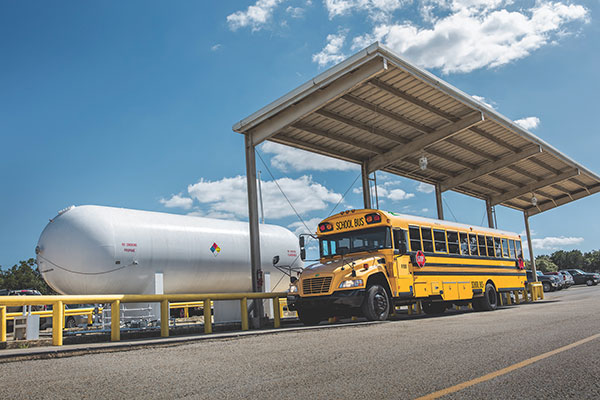Sustainability in Schools: 7 ideas for engaging students, communities in green initiatives
Apr 10, 2023 03:33AM ● By Family Features
As the center of many communities, schools can play an important role in promoting sustainable behaviors. Teaching earth-friendly behaviors is one aspect, but schools can also take steps to facilitate sustainable practices within the school system and the community.
Beyond protecting the climate and environment, sustainable practices offer multiple benefits, including improving student health and enhancing the community. These green changes can make a meaningful and lasting impact.
Start a Recycling Club
For communities without a city-wide recycling program, a student-run operation can be highly successful. Engaging students in the planning and oversight of a social service project equips them with leadership experience while showing them firsthand the impact a small group can make.
Look at Propane Buses
 Diesel school buses are not only expensive to operate, but they pose a risk to children’s health and the environment. According to the Propane Education & Research Council, with propane school buses, the classic cloud of black smoke emitted from the tailpipe is nonexistent. Propane school buses also provide a quieter ride than diesel buses, which means it’s a safer ride. What’s more, propane reduces harmful emissions that cause asthma, bronchitis and other respiratory illnesses by up to 94% compared to diesel.
Diesel school buses are not only expensive to operate, but they pose a risk to children’s health and the environment. According to the Propane Education & Research Council, with propane school buses, the classic cloud of black smoke emitted from the tailpipe is nonexistent. Propane school buses also provide a quieter ride than diesel buses, which means it’s a safer ride. What’s more, propane reduces harmful emissions that cause asthma, bronchitis and other respiratory illnesses by up to 94% compared to diesel.
There are two practical energy choices for clean student transportation: propane and electric. However, a propane bus costs one-third the price of an electric bus, allowing school districts to replace their aging diesel fleets three times faster than with electric. In addition, propane has a range of 400 miles, meaning even sizable vehicles, like buses, can go the distance to provide a reliable ride.
Clean with Natural Products
Especially in the wake of a global pandemic, cleaning standards in most schools are exceptionally high. However, many of the heavy-duty disinfectants and other cleaning agents used in schools and other public areas can be filled with chemicals that negatively affect air quality and further harm the environment when they wash into surrounding areas, including streams and rivers.
Plant a School Garden
Locally sourced produce offers numerous benefits, from providing an affordable food source for families in the area to minimizing costs associated with food production, including transportation and packaging. Beyond the social and environmental perks, gardening is a valuable life skill that can also be easily woven into academic lessons such as science, math, social studies and even art.
Take Advantage of Natural Light
In many cases, classrooms that are well-illuminated by natural light filtering through windows don’t need to run overhead lights throughout the day. Leveraging the warmth of the sun’s rays can also be helpful in providing natural heat during colder months.
Replace Light Bulbs
In areas where the school does rely on energy-based lighting, environmentally friendly bulbs make a lot of sense. Not only do eco-friendly bulbs align with a school’s commitment to sustainability, but they’re also generally more cost-efficient to operate, which means the district can save money on energy expenses.
Celebrate Environmental Holidays
Engaging students and capturing their interest can also mean tapping into the delight that comes with classroom parties and special events that offer a break from the regular school routine. Hosting assemblies or organizing special events in honor of environmental holidays can pique students’ interest and inspire them to take a greater interest in adopting sustainable habits.
A Program Geared for Sustainability
In an effort to provide school districts with more environmentally friendly transportation, the Environmental Protection Agency’s Clean School Bus Program is providing $5 billion over five years (2022-2026) to replace existing school buses with zero-emission and low-emission models.
The program prioritizes high-need, low-income, rural and tribal school districts. As an affordable, available energy source that provides fleets with a range of up to 400 miles on a single refuel, propane autogas is a viable option for each of these prioritized demographics.
In 2022, the EPA solicited rebate applications for $1 billion for zero-emission and low-emission school bus rebates as the first funding opportunity. The $1 billion paid for 2,350 electric school buses. The funding also awarded 109 low-emissions propane buses.
However, the same amount of money distributed for electric buses could have helped fund as many as 29,000 propane buses, assuming each bus received the $30,000 incentive from the program.
The 2,350 diesel buses the grant replaced with electric will reduce nitrogen oxide emissions by 665 metric tons per year and carbon dioxide emissions by 36,870 metric tons. If the funds went toward the 29,000 propane buses to replace diesel, it would have reduced nearly 10 times the amount of nitrogen oxide emissions and three times the amount of carbon dioxide emissions.
This year, parents can start the conversation with their school transportation officials about clean propane buses so they’ll be ready to apply when the time comes. Learn more about how parents can start the conversation at BetterOurBuses.com.
